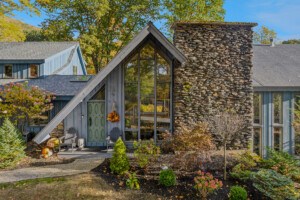History Reimagined in Beacon Hill
Stern McCafferty balances new and old. By Liana Schaffner
Outfitted with an inviting bar area and Bensen club chairs, the living room on the second floor has the feel of a hotel lounge, the design team says. / Photograph by Eric Roth
From the outside, the Beacon Hill townhouse boasts all the proud attributes of a 19th-century landmark: handsome brick façade, black shutters, and a wealth of windowpanes tinted with age. The effect is seamless—and slightly deceptive. “We repaired and replaced much of the [home’s exterior]; it’s essentially new,” says David Stern, a principal of the Boston-based firm Stern McCafferty Architecture + Interiors. Only those slightly muted windows provide a vague glimpse into the house’s past. “The windows contain antique glass, for a sense of continuity,” Stern says. “Our goal was to honor the home’s history in subtle ways.”
These subtle details surface throughout the interior, a picture of contemporary sleekness. The crisp aesthetic reflects the modern tastes of the homeowners, who purchased the property after outgrowing their previous Beacon Hill address several years ago. While the 7,000-square-foot dwelling affords the couple and their two young daughters an abundance of space, its original format felt crowded and stifling to them. “It was very traditional, dripping with paneling and molding, and there was even an apartment for a butler,” Stern says. “The owners had an entirely different vision of how they wanted to live, which was more modern and stripped down.”
To “free up” the pinched entry level, Stern converted a cluster of rooms into an airy parlor that segues into a formal dining room. Here, the family gathers for dinner around a linear glass table that Stern designed in-house with the firm’s other principal, Diane McCafferty. “The idea was to create a big table that echoes the length of the room, but doesn’t actually look or feel like a big table,” says McCafferty, who added a sculptural light fixture by David Weeks Studio for a strong focal point (“Every room has a distinct character derived from the decorative lighting,” Stern says). A pair of traditional-looking built-in cabinets exhibits the warmth and richness of wood, though they’re actually clad in leather. While the dining room conveys lightness and modernity, one existing feature presented a cumbersome challenge. “There was an elevator in the [back of the room] that blocked out natural light and clogged up the whole corner of the house,” Stern says. The owners wanted it removed. “The realtor told them they were crazy,” he says.
To be fair, the realtor had a point: An elevator has its advantages in a vertical, six-story structure. But the owners had little need (or patience) for the slow-moving contraption, preferring to stick with stairs and an intercom system instead. Eager to repurpose the area once belonging to the elevator shaft, Stern introduced an enclosed central courtyard accessible via the dining room’s new French doors. On the floor above, a balcony overlooks the strategically positioned space. “Beacon Hill gardens are typically at the very end of the house, so you can only see [them] from one room,” Stern says. “Here, we were able to capture the garden within the volume of the house so you’re seeing it from multiple spaces and different vantage points.”
The parlor features a Flexform “Wing” sofa and “Lima” chairs by Tacchini. / Photograph by Eric Roth
Sculptural light fixtures lend each room character and dimension. / Photograph by Eric Roth
In the kitchen, views of the courtyard filter through expansive windows, adding dimension to the galley-like space (which, in true Federal fashion, previously included a small bedroom, an ironing room, and a pantry). A streamlined wall of glass cabinets by Valcucine slide open to reveal appliances, and close again to eliminate clutter. This practical theme continues into the family’s breakfast area, where custom cabinets fabricated by Herrick & White conceal a pantry and a small refrigerator. The room is informal in spirit, but lush with detail. Oak paneling adds texture, while a striking custom mosaic, rendered by the Boston-based company Artaic, delivers a playful, poignant touch. “That’s a family photograph,” says McCafferty of the black-and-white image, snapped by one of the homeowners, who’s a professional photographer.
The firm also implemented significant changes on the second floor, accessed by a distinctive spiral staircase. Rebuilt in its original location to preserve a classic sense of proportion, it leads to an enormous living room and bar area that exudes the chic, relaxed feel of a hotel lounge. Twin fireplaces constructed with stone tile display sharp, clean lines—partially thanks to an epiphany on the part of McCafferty, who decided not to grout them. “It’s my new thing,” she says. The team also replaced the room’s original crown molding with a lighter, more sinuous trim. A home office with a skylight and a “super-cozy” fireplace has sliding cabinets, in the same organized spirit of the kitchen.
Framed by a graphic Trove wallcovering, an antique mirror above the bar recalls the home’s historical roots. / Photograph by Eric Roth
The impression of order continues up to the third floor, where the team created a master suite and bath. Here, custom quartzite counters and stone partitions, designed in-house, add scale and heft. The fourth floor is made up of two children’s bedrooms with attached bathrooms, while the fifth floor is home to a casual family room and additional workspace. The basement consists of a mudroom, a wine cellar, and a guest bedroom.
The entire process took the team about two years to complete, with much of the build informing the interior design. “We start with the whole picture and work our way down to the details,” McCafferty says. Those carefully considered details don’t exist to force a balance between contemporary and classic elements, but to give the home new character. “Our theory is that to respect the old, you have to make the new distinct,” Stern says. The result isn’t a fusion of the centuries but a kind of coexistence—lucid, dissimilar, exciting. A most modern arrangement.
Plans for the first three floors of the townhouse.
In the breakfast area, a family photograph is reimagined as a mosaic, fabricated by Artaic. / Photograph by Eric Roth
The family dines at a glass table designed by Stern McCafferty. / Photograph by Eric Roth
A sliding glass cabinet by Valcucine conceals kitchen appliances. / Photograph by Eric Roth
Natural light from the courtyard floods the dining room. / Photograph by Eric Roth
Striped marble walls fabricated by Cumar informed the master bath’s linear design. / Photograph by Eric Roth
A freestanding tub from Blu Bathworks graces the master bath. / Photograph by Eric Roth
Boasting a cozy reading nook, this child’s bedroom reflects its owners’ “earthy” aesthetic, Stern says. / Photograph by Eric Roth
An Eazywallz cloud mural and glass balloon lamps add whimsy to a child’s bedroom. / Photograph by Eric Roth
In the home office, “Grand Repos” lounge chairs from Vitra create a sculptural focal point. / Photograph by Eric Roth
An Apparatus light fixture and custom mirrors designed by the firm welcome guests in the entry. / Photograph by Eric Roth
From the outside, the townhouse blends in with its historical neighbors. / Photograph by Eric Roth


